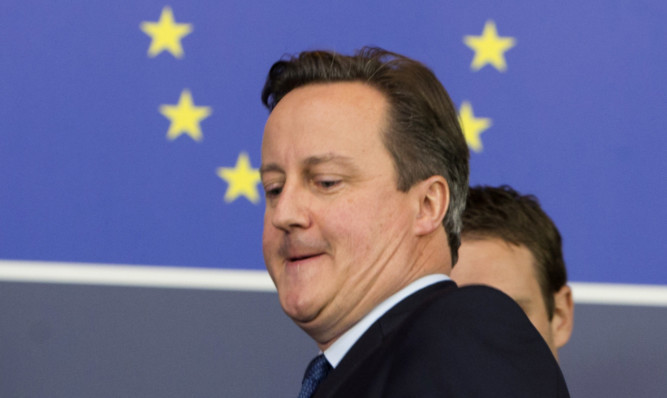David Cameron has insisted a deal on Britain’s EU renegotiation demands can be finalised by February despite warnings from fellow leaders that his proposals could be “unacceptable”.
The Prime Minister emerged from four hours of gruelling talks over dinner in Brussels, arguing that there was now a “pathway” to an agreement.
He denied that his demand for a four-year ban on migrants claiming in-work benefits had been swept off the table by counterparts worried about undermining the EU principle of free movement.
But European Council president Donald Tusk said there could be no “discrimination” on the basis of nationality, while German chancellor Angela Merkel promised to protect the “pillars” of the union.
Speaking at a hastily-arranged press conference after the talks – during which he had to replace a wonky British crest drooping off the podium – Mr Cameron said: “I would say today what has happened is we have taken a big step to a better deal for Britain but there is still a lot of hard work to be done, and it is going to need to be done between now and February 18.
“But there is a path through this to a better deal for Britain.”
Mr Cameron said he believed questions about how to make the reforms legally enforceable could also be overcome.
“If treaty change is necessary and I believe it is there should be a way to deliver that treaty change … I believe there is a good way through that,” he said.
The premier denied that he had been forced to back down on his plan for restricting in-work benefits. “In terms of welfare, no I haven’t put any other proposals on the table – I have put my four year proposal on the table and it remains on the table,” he said.
“The commission said that they believed there were solutions – not compromises, solutions. I am confident after tonight that we can find solutions.”
Mr Cameron said nothing was “certain” but there was clear “momentum” towards a deal, expressing confidence that it could be done by the next European Council summit in February.
“Nothing is certain in life, nor in Brussels, but what I would say is there is a pathway through this to a deal in February,” he added.
At a separate press conference, Mr Tusk said he would aim to table a text on proposed reforms at the February gathering.
Mr Tusk characterised the discussions over dinner as “substantive and constructive”, while again dismissing the idea that any proposals could be discriminatory.
“Prime Minister Cameron set out in detail his position, in particular regarding benefits and free movement,” said the council president.
“He explained his request for a model based on four years and reiterated his openness to alternative solutions only if they could achieve the same objective.
“Leaders voiced their concerns but also demonstrated willingness to look for compromises.”
Mrs Merkel suggested treaty change could achieved if needed. “It is not something that can happen now but it can later,” she said.
Mr Cameron has already made clear he is willing to consider alternatives that would reduce migration “pull factors”. But although officials are thought to be working on options – such as an “emergency brake” on excessive inflows or a residency test – no other plans have been formally put on the table.
In a 40-minute presentation – described by UK sources as his longest ever speech to leaders at an EU summit – Mr Cameron sought to persuade them that British worries must be accommodated ahead of the looming in-out referendum.
“The levels of migration we have seen in a relatively short period of time are unprecedented, including the pressures this places on communities and public services,” he said.
“This is a major concern of the British people that is undermining support for the European Union.”
The Prime Minister is under intense domestic pressure to secure substantial concessions ahead of the referendum on EU membership promised by the end of 2017. Downing Street has said his presentation to leaders – over a dinner without any of their diplomatic entourage – was designed to put some political momentum into the renegotiation process.
Mr Cameron has already been forced to abandon his initial hope that a deal could be finalised before Christmas, and now hopes it will be possible by the next summit in February. June is widely mooted as his favoured schedule for holding the referendum, before a summer in which Europe’s migrant crisis could reach new heights.
French president Francois Hollande appeared to suggest at his press conference that the poll would take place in the middle of next year – but Mr Cameron denied discussing the timing over dinner.
